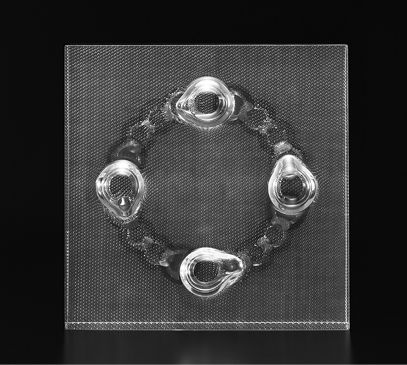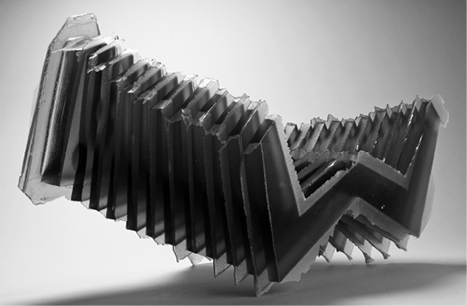Discussion
講評会
Comments on Top Prize Winners
(4/4)

めぐり
Circulation
所 志帆 TOKORO, Shiho
(JAPAN)

オブジェ 1301
Object 1301
桃原 和広 MOMOHARA, Kazuhiro
(JAPAN)
Takeda ───── Then, Professor Carlson will talk about “Circulation” by TOKORO Shiho (Japan).
Carlson ───── This piece, I think, is again different representation with glass. If you look at it, it tells a story. A story is of somehow, someway an artist decided to capture air from our environment and have that air be the animation in the motivation,in the kinetic force in this piece.
As we looked at the piece yesterday, it was really quite wonderful in the room where we can see it easily from both sides. I think these photos do not necessarily do it justice. But when we see it in gallery space, we will see that there is an inner life to this piece. The square format is nearly the parameter by which the piece is contained. But the bubbles are a kind of activity and a kind of blisters that burst into the surface and make it a piece that has a quality of water and quality of transformation.
As artists and as makers of objects, we sometimes are distracted from a singular vision. I think this artist has a singular vision and phenomena that is the voice that he has developed or she has developed.
Takeda ───── I will tell you the size of this work, 35cm x 35cm.I think this is the maximum size created with this particular technique. Next, Professor Laursen, please make a comment on “Object 1301” by MOMOHARA Kazuhiro (Japan). It is 35cm in height and 60cm in length.
Laursen ───── It is a very interesting work. You see at the slide which is a very good slide I could say. The work is interesting.Its form and the seeming instability of the sculpture.My first impression was that of the musical instrument,an accordion with the repetitive rhythm at the core of the sculpture.
Later, I have read that this sculpture is indeed about music.The work is cast in ceramic fiber mold and the technique is used with great skill for the sculpture.
It is full of vitality. It moves in more directions, but still it is kept together in one big dominating form and color scheme.I really think that this artist has succeeded in giving form in glass to notes and music. And with these steering qualities I think this piece of work really, fully deserves the Honorable Mention.
Takeda ───── Professor Carlson, please comment on the same work.
Carlson ───── With this piece we see really a different sense of completion. Many of us go back, grind and identify the location on a piece. We will grind the surface away or polish the surface. We change the shape after all of the process, the heat process as it has been included.
The wonderful honesty and energy for me are within this piece because it has not been altered when it came out the mold. The mold is removed, the piece is cleaned, but there is no attempt to grind, polish and remove that flashing out of that part of the heat and the mold material. It is a threat for all of us to see. Some are dangerous. We could cut with it. It might even break the edge, but the piece has an energy because of that. I think it is quite special.
Takeda ───── That is all for the Honorable Mention winners.

